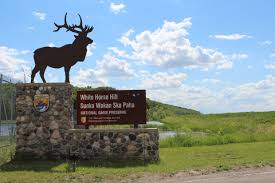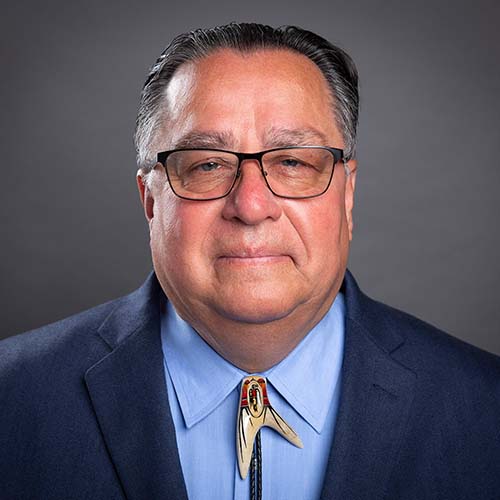
- Details
- By Native News Online Staff
In a landmark decision reaffirming its commitment to Tribal self-governance, the United States government has returned 680 acres of hay ground to the Spirit Lake Nation. This long-awaited victory follows a determined 65-year effort by the tribe to reclaim lands deemed “submarginal” and previously designated as excess to the needs of the White Horse Hill National Game Preserve.
Originally part of the Spirit Lake Nation’s reserved territory, these lands were set aside in 1904 by President Theodore Roosevelt for Bureau of Indian Affairs (BIA) Agency Reserve purposes, primarily for education and government services. In the late 1950s, the tribe formally petitioned for their return as part of a broader congressional movement to restore submarginal lands to Indigenous nations. However, the U.S. Fish and Wildlife Service (USFWS) retained the property, using it to produce hay for the buffalo population at White Horse Hill.
In recent years, the USFWS ceased utilizing the land, rendering it surplus to its needs. This prompted the General Services Administration (GSA) to approve its return, marking a significant milestone in U.S.-tribal relations. The decision underscores a renewed focus on honoring treaties, strengthening government-to-government relations, and upholding commitments to Indigenous communities.
"This return of land is a significant step towards healing and reconciliation. After decades of effort, we are grateful for the support of our partners in the government and the recognition of our rightful claim to these lands," Chairperson Lonna Jackson-Street commented, "We also extend our gratitude to the previous administration under the leadership for former Chairman, Douglas Yankton, and their efforts in laying the foundation to reclaim these lands. This is not just about regaining land; it is about celebrating our history, culture, and the future of our tribe's legacy."
The Spirit Lake Nation is eager to embrace the opportunities this land offers for the community, with a steadfast commitment to sustainable stewardship and honoring the legacy of their ancestors.
More Stories Like This
50 Years of Self-Determination: How a Landmark Act Empowered Tribal Sovereignty and Transformed Federal-Tribal RelationsDenied Trip to Alcatraz, Leonard Peltier Tells Sunrise Gathering: “My Heart Is Full”
‘Meet your prayer halfway’ | Women-Led Bison Harvests Bring Tribal Food Sovereignty
San Manuel Tribe Reclaims Ancestral Name, Faces Vandalism on Holiday
Minnesota Wild Makes History with First-ever Ojibwe-language NHL Broadcast
Help us tell the stories that could save Native languages and food traditions
At a critical moment for Indian Country, Native News Online is embarking on our most ambitious reporting project yet: "Cultivating Culture," a three-year investigation into two forces shaping Native community survival—food sovereignty and language revitalization.
The devastating impact of COVID-19 accelerated the loss of Native elders and with them, irreplaceable cultural knowledge. Yet across tribal communities, innovative leaders are fighting back, reclaiming traditional food systems and breathing new life into Native languages. These aren't just cultural preservation efforts—they're powerful pathways to community health, healing, and resilience.
Our dedicated reporting team will spend three years documenting these stories through on-the-ground reporting in 18 tribal communities, producing over 200 in-depth stories, 18 podcast episodes, and multimedia content that amplifies Indigenous voices. We'll show policymakers, funders, and allies how cultural restoration directly impacts physical and mental wellness while celebrating successful models of sovereignty and self-determination.
This isn't corporate media parachuting into Indian Country for a quick story. This is sustained, relationship-based journalism by Native reporters who understand these communities. It's "Warrior Journalism"—fearless reporting that serves the 5.5 million readers who depend on us for news that mainstream media often ignores.
We need your help right now. While we've secured partial funding, we're still $450,000 short of our three-year budget. Our immediate goal is $25,000 this month to keep this critical work moving forward—funding reporter salaries, travel to remote communities, photography, and the deep reporting these stories deserve.
Every dollar directly supports Indigenous journalists telling Indigenous stories. Whether it's $5 or $50, your contribution ensures these vital narratives of resilience, innovation, and hope don't disappear into silence.
 The stakes couldn't be higher. Native languages are being lost at an alarming rate. Food insecurity plagues many tribal communities. But solutions are emerging, and these stories need to be told.
The stakes couldn't be higher. Native languages are being lost at an alarming rate. Food insecurity plagues many tribal communities. But solutions are emerging, and these stories need to be told.
Support independent Native journalism. Fund the stories that matter.
Levi Rickert (Potawatomi), Editor & Publisher

